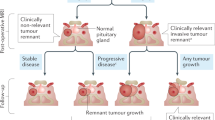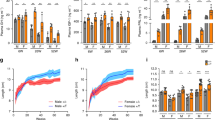Abstract
Pituitary tumors are commonly encountered, and result from clonal expansion of a single mutated cell1. Hypothalamic hormones, local growth factors and circulating sex steroid hormones promote pituitary tumor growth and expansion into large invasive tumors2. Estrogen acting directly through its receptor and by stimulation of fibroblast growth factor regulates prolactin synthesis and secretion3,4. Fibroblast growth factor-2 (bFGF) modulates angiogenesis, tumor formation and progression in many tissues, including the anterior pituitary5,6,7,8. A pituitary tumor-derived transforming gene (PTTG) has been isolated, which is tumorigenic in vivo, regulates bFGF secretion, and inhibits chromatid separation9,10,11. The human PTTG family consists of at least three homologous genes, of which PTTG1 is located on chromosome 5q3312 and is expressed at low levels in most normal human tissues but is highly expressed in malignant human cell lines and in pituitary tumors13. We report here that pituitary pttg is regulated in vivo and in vitro by estrogen. Maximal induction of rat pituitary pttg mRNA in vivo occurred early in pituitary transformation (normal cell to hypertrophic/hyperplastic cell), coincident with bFGF and vascular endothelial growth factor induction and pituitary angiogenesis. We also demonstrate that pttg expression is induced by bFGF, and show concordant pttg and bFGF expression in experimental and human pituitary adenomas. As bFGF and estrogen both induce pttg, and pttg expression coincides with the early lactotrophic hyperplastic response, angiogenesis and prolactinoma development, we propose a previously unknown paracrine growth factor-mediated mechanism for pituitary tumor pathogenesis and potentially other estrogen-regulated tumors.
This is a preview of subscription content, access via your institution
Access options
Subscribe to this journal
Receive 12 print issues and online access
$209.00 per year
only $17.42 per issue
Buy this article
- Purchase on Springer Link
- Instant access to full article PDF
Prices may be subject to local taxes which are calculated during checkout



Similar content being viewed by others
References
Shimon,I., Melmed, S. Genetic basis of endocrine disease: pituitary tumor pathogenesis. J. Clin. Endocrinol. Metab. 82, 1675–1681(1997).
Wilson, C.B. Extensive personal experience: Surgical management of pituitary tumors. J. Clin. Endocrinol. Metab. 82, 2381–2385(1997).
Gothard, L. Q., Hibbard, J.C. & Seyfred, M.A. Estrogen-mediated induction of rat prolactin gene transcription requires the formation of a chromatin loop between the distal enhancer and proximal promoter regions. Mol. Endocrinol. 10, 185–195 (1996).
Scully, K.M. et al. Role of estrogen receptor- α in the anterior pituitary gland. Mol. Endocrinol. 11, 674–681 (1997).
Baird, A. et al. A nonmitogenic pituitary function of fibroblast growth factor: regulation of thyrotrophin and prolactin secretion. Proc. Natl. Acad. Sci. USA 82, 5545–5549 (1985).
Smallwood, P. et al. Fibroblast growth factor (FGF) homologous factors: new members of the FGF family implicated in nervous system development. Proc. Natl. Acad. Sci. USA 93, 9850–9857 (1996).
Li, Y. et al. Identification and characterization of high molecular weight forms of basic fibroblast growth factor in human pituitary adenomas. J. Clin. Endocrinol. Metab. 75, 1436–1441 (1992).
Zimmering, M.B. et al. Increased basic fibroblast growth factor in plasma from multiple endocrine neoplasia type-1: relation to pituitary tumor. J. Clin. Endocrinol. Metab. 76, 1182–1187 (1993).
Pei, L. & Melmed S. Isolation and characterisation of a pituitary tumor-transforming gene (PTTG). Mol. Endocrinol. 11, 433–441(1997).
Zhang, X. et al. Structure, expression and function of human pituitary transforming gene (PTTG). Mol. Endocrinol. 13, 156–166 (1999).
Zou, H., McGarry, T.J., Bernal, T. & Kirschner, M.W. Identification of a vertebrate sister-chromatid separation inhibitor involved in transformation and tumorigenesis. Science 285, 418–422 (1999).
Prezant, T.P., Kadioglu, P., Melmed, S. An intronless homolog of human proto-oncogene hPTTG is expressed in pituitary tumors:evidence for hPTTG family. J. Clin. Endocrinol. Metab. 84, 1149–1152 (1999).
Zhang, X. et al. Pituitary tumor transforming gene expression in human pituitary adenomas. J. Clin. Endocrinol. Metab. 84, 761–767 (1999).
Seghezzi, G. et al. Fibroblast growth factor-2 (FGF-2) induces vascular endothelial factor (VEGF) expression in the endothelial cells of forming capillaries: an autocrine mechanism contributing to angiogenesis. J. Cell. Biol. 141, 1659–1673 (1998).
Shupnik, M.A. & Rosenzweig, B. Identification of an estrogen-responsive element in the rat LHβ gene. J. Biol. Chem. 26, 17084–17091 (1991).
Hanahan, D. & Folkman, J. Patterns and emerging mechanisms of the angiogenic switch during tumorigenesis. Cell 86, 353–364 (1996).
Weiner, R. I., Elias, K.A. & Monnet, F. in Prolactin. Basic and Clinical Correlates (eds. Macleod, R.M., Thorner, M.O. & Scapagnini, U.) 641–653 (Liviana Press, Padova, Italy, 1995).
Kovacs, K., Ryan, N., Horvath, E., Ezrin G. & Penz, G. Prolactin cell adenomas of the human pituitary. Morphological features of prolactin cells in the nontumorous portions of the anterior lobe. Horm. Metab. Res. 10, 409–412 (1978).
Schecther, J., Goldsmith, P., Wilson, C. & Weiner, R. Morphological evidence for the presence of arteries in human prolactinomas. J. Clin. Endocrinol. Metab. 67, 713–719 (1988).
Serri, O., Noiseux, D., Robert, F. & Hardy, J. Lactotroph hyperplasia in an estrogen treated male-to-female transsexual patient. J. Clin. Endocrinol. Metab. 81, 3177–3179 (1996).
Stefaneanu, L. et al. In situ hybridisation study of estrogen receptor messenger ribonucleic acid in human adenohypophysial cells and pituitary adenomas. J. Clin. Endocrinol. Metab. 78, 83–88 (1994).
Wiklund, J., Wertz, N. & Gorski, J. A comparison of estrogen effects on uterine and pituitary growth and prolactin synthesis in F344 and Holtzman rats. Endocrinology 109, 1700–1707(1981).
Acknowledgements
We thank L. Chen and M. Perone for technical support. This work was supported by NIH grant CA75979 (S.M.); a Fulbright Research Scholarship; The Sir Samuel Leonard Simpson Fellowship; and an Endocrine Foundation Fellowship (A.P.H.).
Author information
Authors and Affiliations
Corresponding author
Rights and permissions
About this article
Cite this article
Heaney, A., Horwitz, G., Wang, Z. et al. Early involvement of estrogen-induced pituitary tumor transforming gene and fibroblast growth factor expression in prolactinoma pathogenesis. Nat Med 5, 1317–1321 (1999). https://doi.org/10.1038/15275
Received:
Accepted:
Issue Date:
DOI: https://doi.org/10.1038/15275
This article is cited by
-
ACT001 inhibits pituitary tumor growth by inducing autophagic cell death via MEK4/MAPK pathway
Acta Pharmacologica Sinica (2022)
-
A systematic review of molecular alterations in invasive non-functioning pituitary adenoma
Endocrine (2022)
-
The role of MAPK11/12/13/14 (p38 MAPK) protein in dopamine agonist-resistant prolactinomas
BMC Endocrine Disorders (2021)
-
Genomics and Epigenomics of Pituitary Tumors: What Do Pathologists Need to Know?
Endocrine Pathology (2021)
-
Inhibiting MAPK14 showed anti-prolactinoma effect
BMC Endocrine Disorders (2020)



